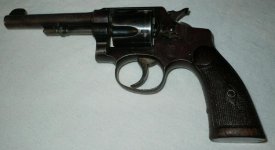OP
Green Frog
Member
This is terrible. I feel like a traitor to my 1911s. After reading this entire thread I realize I must have an I frame. My ten year old daughter has fired my K200 but it's a little awkward for her. Now to convince the wife the girl really needs one of these....
What's so terrible? A father has no higher calling than to make his daughter safe and self reliant. A nice small Model 30 dash whatever J-frame, or its ancestor, the .32 Hand Ejector I-frame is just the thing to teach both gun safety and the beginnings of self defense. My 20 year old niece (who probably isn't much bigger than your 10 year old) is learning on a 3" Model 30-1 from my stable and expects it to become hers in 3 months when she reaches "the big two-one."
Froggie
















